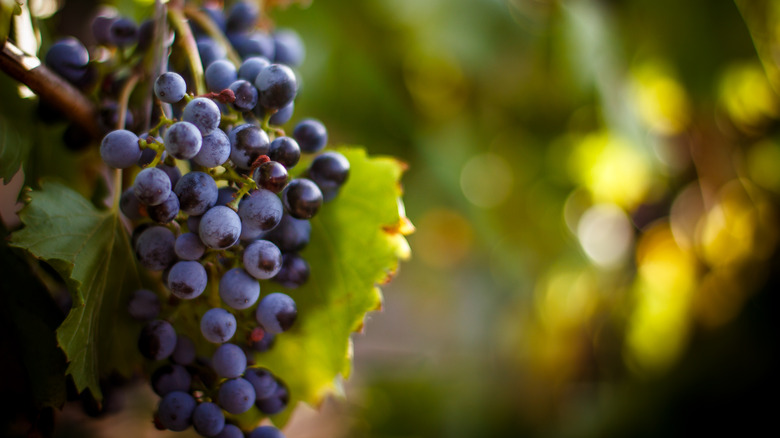In Baja California, Mission Grapes Carry On 500 Years Of Wine Tradition
Today, mission grapes are dominating California's wine scene. A Los Angeles Times article from 2019 bore the headline: "The Mission grape is cool in L.A. again, thanks to the natural wine movement." Indeed, natural wine went on to emerge as a pretty defining trend of 2022, says The Wall Street Journal, and mission grapes take the word "natural" to another level. Some tasters might argue that "funk" is a more fitting word. According to the Times, wine made from mission grapes smells like mezcal. California wine historian Ned Teitelbaum says it tastes like "a wet hamster going down," and Jill Bernheimer of Domaine L.A. says it tastes like blood.
Mission grapes are characterized by their almost black darkness, high sugar, low acidity, and floral scent, says Specialty Produce, but they go by many different names. In Argentina, they're called "criolla chica." They're "pais" in Chile and "palamino negro" in the Canary Islands." California's mission grapes are the oldest cultivated vinifera grape species in the U.S., a particularly interesting fact considering some of the mission grape's contemporary appeal is that it defies the "pretty" mainstream wine scene. In their elusive, earthy, iconoclastic profile, mission grapes and their wine tote a stylish "in" factor, says the Times. But, in Baja California, mission grapes have been around for centuries — they carry on 500 years of wine tradition.
Transcending cultures and geographic borders
Mission grapes may play a fashionable role in the contemporary Cali wine scene, but they didn't actually come to the U.S. until the mid-1700s, per Specialty Produce. Before that, they were flourishing in Baja California, a peninsula along the northwestern coast of Mexico, per Britannica. The region has mountains and volcanoes, but (perhaps most notably to sommeliers) it also has lots of fertile land for agriculture.
Mission grapes first took root in the Castilla la Mancha region of Spain, says National Geographic, and were largely established by famed Spanish conquistador Hernán Cortés (the same guy who toppled the Aztec empire, per History.com). When Cortés hit Mexican shores in 1522, he ruled that 1,000 grapevines should immediately be planted per every 100 people to ensure there would be enough wine to go around. Mission grapevines were the perfect strain for the job: their heartiness and high resistance to drought made their intercontinental voyage possible. According to the Wine History Project of San Luis Obispo County, California, a single mission grapevine can live for well over 100 years. Conveniently, Baja's climate (sunny, cool, coastal breezes, adequately irrigated) turned out to provide ideal growing conditions. Mission grapes were further cemented in Baja wine culture as Catholic priests were conducting missions along Baja's coastline and carting along wine to perform the sacrament. Enter: the mission grape's religious namesake. Five hundred years later, the hardy grape is experiencing a resurgence.

